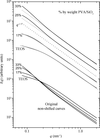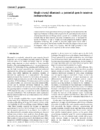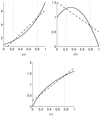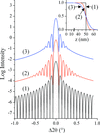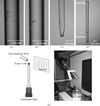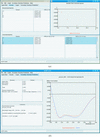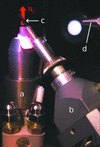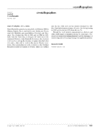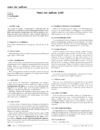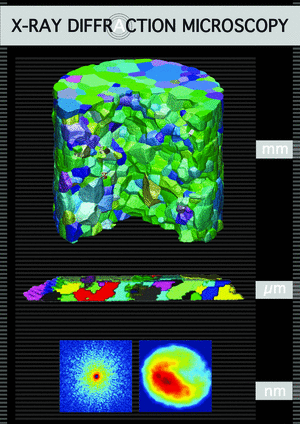issue contents
February 2009 issue

Cover illustration: Three-dimensional reconstructed crystal (purple), loop (yellow) and solvent (transparent pink) for a native DNA sample. Courtesy of Brockhauser, Di Michiel, McGeehan, McCarthy & Ravelli [J. Appl. Cryst. (2008), 41, 1057-1066].
research papers
An approach is proposed providing the means for determining stacking fault properties by analysis of the relative positions of selected pairs of X-ray diffraction peaks.
Small-angle X-ray scattering was used to study modifications in the correlation function in tetraethoxysilane-derived poly(vinyl alcohol)/silica hybrids. An additional scattering at low q was found to overlap the fundamental mass-fractal scattering from the basic silica. The fraction of both contributions to the total correlation function was estimated; this is the first time that such a study has been carried out for mass-fractal structures.
The high-pressure behavior of nanocrystalline mackinawite (FeS) has been studied by X-ray total scattering experiments and pair distribution function analysis. A pressure-induced structural phase transition has been observed at about 3 GP and from the tetragonal mackinawite structure to orthorhombic FeS-II.
The matrix method for diffuse scattering was effectively used to simulate powder X-ray diffraction patterns of misfit mixed-layer compounds in a restacked binary nanosheet system.
A joint probability distribution function method is described for finding the anomalous scatterer positions from two-wavelength powder data.
It is shown theoretically that single-crystal diamond would be the ultimate neutron monochromator material if it were available as large mosaic crystals. Present chemical vapour deposition growth techniques are capable of preparing single crystals with a suitable mosaic spread and should be further developed with the aim of producing neutron monochromators.
The problems associated with cooling powder samples below 1 K are discussed. Two strategies for mounting neutron powder diffraction samples are described and evaluated.
An investigation of the usefulness of higher-order least-squares fits in the post-processing of intensity measurements is presented.
Atomic coordinate analysis allows the property of ferroelectricity, previously unsuspected in a material, to be recognized if its crystal structure is known. An earlier such prediction that NaSb3F10 is ferroelectric is unambiguously confirmed.
Download citation


Download citation


Open  access
access
 access
accessThe title 1,1′-disubstituted ferrocene derivative exhibits a nematic phase only, and the rod-like shape of the molecule favors liquid crystalline behavior. C—H⋯π, π–π and T-stacking interactions play a major role in stabilizing the molecular packing arrangement and the mesomorphism.
The technique of neutron polarization analysis spectroscopy on a multi-detector instrument is described.
A simple model-independent method is proposed to retrieve strain profiles in thin films using X-ray diffraction. The dynamical diffraction from the substrate as well as the film thickness fluctuations are explicitly taken into account.
The effect of pressure on both the structure and the electrical conductivity of the superionic Ag7GeSe5I phase has been studied at room temperature (i) by powder X-ray diffraction from 0.1 MPa to 10 GPa, (ii) by single crystal X-ray diffraction from 0.1 MPa to 2 GPa and (iii) by impedance spectroscopy from 0.1 MPa to 1.5 GPa. The decrease in conductivity of about one order of magnitude, when the pressure increases up to 1.5 GPa, can be explained by the compression of the cell.
Conventions are proposed to encode information about the diffraction geometry and polarization properties of the incident X-ray beam in an unambiguous and economical way. The use of these definitions is beneficial in the analysis of polarization-dependent phenomena in X-ray diffraction.
Download citation


Download citation


The techniques of synchrotron radiation micro-X-ray fluorescence, neutron diffraction and scanning electron microscopy have been applied to the study of different whewellite kidney stones.
A template-matching-based indexing scheme for Laue diffraction patterns is implemented, and a method is proposed for misorientation determination within a diffracting volume from smeared/split Laue patterns. The methodologies developed are illustrated using micro-Laue patterns obtained from a fatigue crack-wake.
cryocrystallography papers
A small, inexpensive and automatically operated device for the flash annealing of crystals of macromolecules is presented. Operation of the device is completely integrated within the ESRF beamline control graphical user interface for macromolecular crystallography experiments, mxCuBE, and the device can thus be controlled either from the beamline control cabin or by users accessing the beamline remotely.
short communications
This paper presents a hands-free protein crystallography system in which all aspects of crystallographic experiments from crystallization to diffraction data collection are performed within a modified X-ray glass capillary.
An approach is described where structure solution may be attempted from powders with preferential orientation. Based on spherical harmonics, it does not assume any orientation direction but is stable during simulated annealing. The approach relies on a macro keyword already present in TOPAS, but could be implemented in other simulated annealing codes.
computer programs
ACDP is a Java application for processing protein circular dichroism spectra. Three different algorithms for secondary structure deconvolution have been implemented, and spectra can be analysed without the need for data reformatting.
laboratory notes
Additional hard- and software allows computer-controlled temperature-dependent X-ray studies and temperature calibration using a Stoe IPDS II with the Heatstream attachment. The presented software is open source and therefore can easily be adapted to other diffractometer platforms with similar gas flow heaters.
crystallographers
Free 

international union of crystallography
Free 



 journal menu
journal menu









